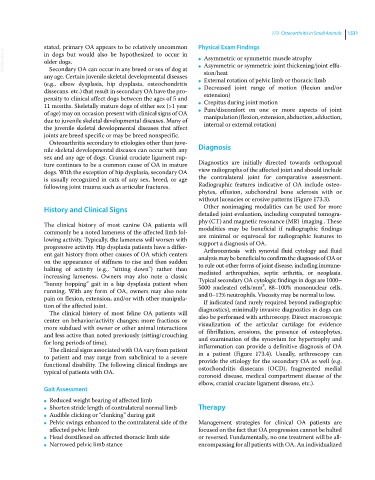Page 1593 - Clinical Small Animal Internal Medicine
P. 1593
173 Osteoarthritis in Small Animals 1531
stated, primary OA appears to be relatively uncommon Physical Exam Findings
VetBooks.ir in dogs but would also be hypothesized to occur in ● ● Asymmetric or symmetric muscle atrophy
older dogs.
Asymmetric or symmetric joint thickening/joint effu-
Secondary OA can occur in any breed or sex of dog at
sion/heat
any age. Certain juvenile skeletal developmental diseases External rotation of pelvic limb or thoracic limb
(e.g., elbow dysplasia, hip dysplasia, osteochondritis ● Decreased joint range of motion (flexion and/or
dissecans. etc.) that result in secondary OA have the pro- ● extension)
pensity to clinical affect dogs between the ages of 5 and Crepitus during joint motion
11 months. Skeletally mature dogs of either sex (>1 year ● Pain/discomfort on one or more aspects of joint
of age) may on occasion present with clinical signs of OA ● manipulation (flexion, extension, abduction, adduction,
due to juvenile skeletal developmental diseases. Many of internal or external rotation)
the juvenile skeletal developmental diseases that affect
joints are breed specific or may be breed nonspecific.
Osteoarthritis secondary to etiologies other than juve-
nile skeletal developmental diseases can occur with any Diagnosis
sex and any age of dogs. Cranial cruciate ligament rup-
ture continues to be a common cause of OA in mature Diagnostics are initially directed towards orthogonal
dogs. With the exception of hip dysplasia, secondary OA view radiographs of the affected joint and should include
is usually recognized in cats of any sex, breed, or age the contralateral joint for comparative assessment.
following joint trauma such as articular fractures. Radiographic features indicative of OA include osteo-
phytes, effusion, subchondral bone sclerosis with or
without lucencies or erosive patterns (Figure 173.3).
History and Clinical Signs Other nonimaging modalities can be used for more
detailed joint evaluation, including computed tomogra-
phy (CT) and magnetic resonance (MR) imaging . These
The clinical history of most canine OA patients will modalities may be beneficial if radiographic findings
commonly be a noted lameness of the affected limb fol- are minimal or equivocal for radiographic features to
lowing activity. Typically, the lameness will worsen with support a diagnosis of OA.
progressive activity. Hip dysplasia patients have a differ- Arthrocentesis with synovial fluid cytology and fluid
ent gait history from other causes of OA which centers analysis may be beneficial to confirm the diagnosis of OA or
on the appearance of stiffness to rise and then sudden to rule out other forms of joint disease, including immune‐
halting of activity (e.g., “sitting down”) rather than mediated arthropathies, septic arthritis, or neoplasia.
increasing lameness. Owners may also note a classic Typical secondary OA cytologic findings in dogs are 1000–
“bunny hopping” gait in a hip dysplasia patient when 5000 nucleated cells/mm , 88–100% mononuclear cells,
3
running. With any form of OA, owners may also note and 0–12% neutrophils. Viscosity may be normal to low.
pain on flexion, extension, and/or with other manipula- If indicated (and rarely required beyond radiographic
tion of the affected joint. diagnostics), minimally invasive diagnostics in dogs can
The clinical history of most feline OA patients will
center on behavior/activity changes; more fractious or also be performed with arthroscopy. Direct macroscopic
visualization of the articular cartilage for evidence
more subdued with owner or other animal interactions of fibrillation, erosions, the presence of osteophytes,
and less active than noted previously (sitting/crouching and examination of the synovium for hypertrophy and
for long periods of time). inflammation can provide a definitive diagnosis of OA
The clinical signs associated with OA vary from patient
to patient and may range from subclinical to a severe in a patient (Figure 173.4). Usually, arthroscopy can
provide the etiology for the secondary OA as well (e.g.
functional disability. The following clinical findings are ostochondritis dissecans (OCD), fragmented medial
typical of patients with OA.
coronoid disease, medical compartment disease of the
elbow, cranial cruciate ligament disease, etc.).
Gait Assessment
Reduced weight bearing of affected limb
●
Shorten stride length of contralateral normal limb Therapy
●
Audible clicking or “clunking” during gait
●
Pelvic swings enhanced to the contralateral side of the Management strategies for clinical OA patients are
●
affected pelvic limb focused on the fact that OA progression cannot be halted
Head dorsiflexed on affected thoracic limb side or reversed. Fundamentally, no one treatment will be all‐
●
Narrowed pelvic limb stance encompassing for all patients with OA. An individualized
●

